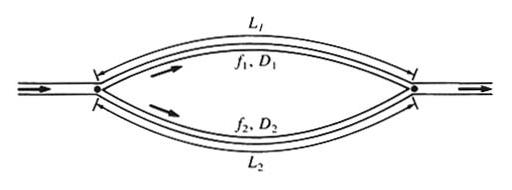CIV E 444 - APPLIED HYDRAULICS
FALL 2009
HOMEWORK No. 7
- Use Fig. 5-6 to solve the Hazen-Williams formula to find the discharge for a pipe with d = 1 ft, S = 0.005, and CH = 130. Verify with ONLINE HAZEN-WILLIAMS.
- A circular conduit delivers water from a reservoir at elevation 3,250 ft, through a power plant, and then discharges to a lake at elevation 1,575 ft. The diameter is d = 1 ft, the head loss per unit of length is hf/L = 0.005, and the velocity is 3 fps. The pipe is 1,200 ft long, has one 45o bend with relative radius r/d = 2, an inlet with relative radius r/d = 0.3, and an outlet with angle θ = 180o and relative radius d1/d2 = 0.4. How many kilowatts of power can be realized if the head loss associated with the turbines is 0.3 of the velocity head?
- Assume three reservoirs A, B, and C connected as shown below. The elevations (relative to C) are: zA = 100 ft, zB = 150 ft, zD = 10 ft.
Line AD is 4,000-ft long and 8-in diameter; BD is 10,000-ft long and 10-in diameter; DC is 5,000-ft long and 12-in diameter. Calculate the discharge in each pipe
and the head at D. Assume f = 0.02 in all pipes. Neglect minor losses.

- A pipeline carrying Q = 20 cfs of water is divided into two pipes 1 and 2. The diameter, length and friction factor of pipe 1 are 12 in, 3000 ft, and 0.02, respectively.
The diameter, length and friction factor of pipe 2 are 16 in, 3200 ft, and 0.03, respectively. Calculate the discharge in each pipe, and
confirm that Q1 + Q2 = Q.
Calculate the head loss through each pipe and confirm that they are the same.
